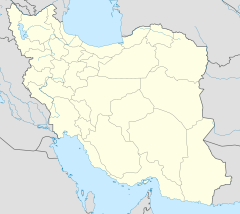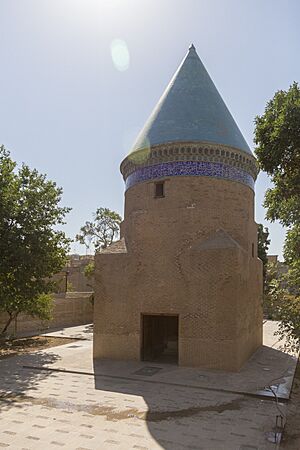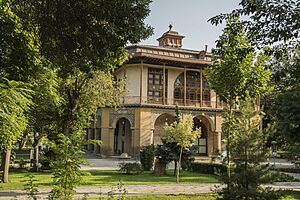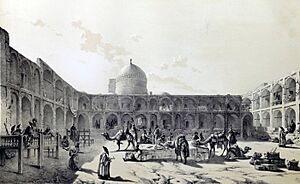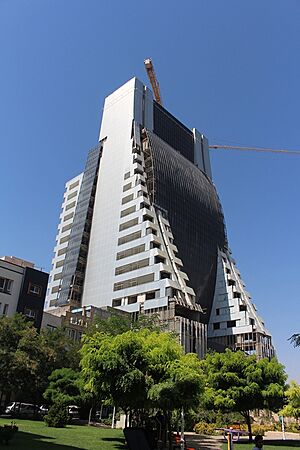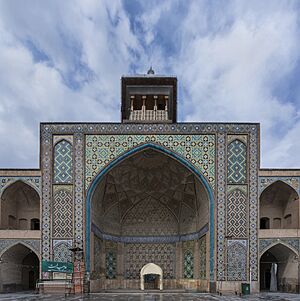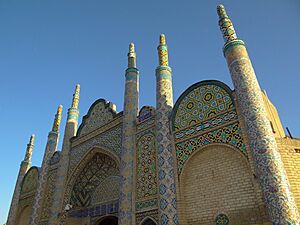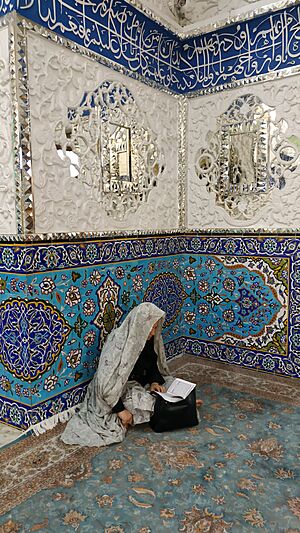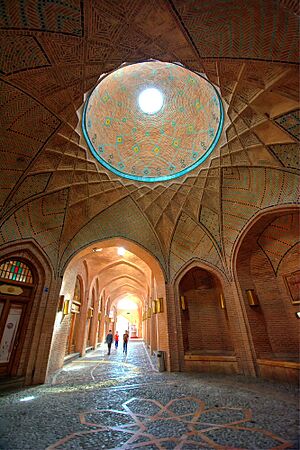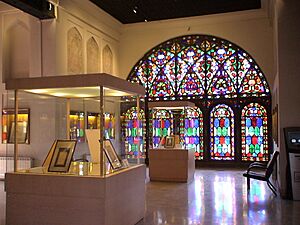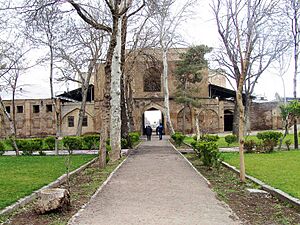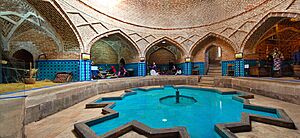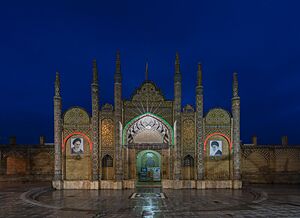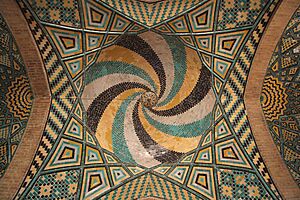Qazvin facts for kids
Quick facts for kids
Qazvin
قزوین
Minoodar, Razhia, Arsas
|
||
|---|---|---|
|
City
|
||
|
.
Left: Chahel Stoun Palace, Aminiha Hosseiniyeh, Anthropology Qajar Bath Musume, Tomb of Hamdollah Mostofi, Right: Shazdeh Hosein Shrine, Caravanserai of Sa'd al-Saltaneh, Qazvin Ghadim Gate, Qazvin Jameh Mosque, Al-Nabi Mosque of Qazvin (all items are from above to bottom)
|
||
|
||
| Motto(s):
Mirror of History & Natural of Iran
|
||
| Country | Iran | |
| Province | Qazvin | |
| County | Qazvin | |
| District | Central | |
| Government | ||
| • Type | City Council | |
| Area | ||
| • Total | 64.132 km2 (24.762 sq mi) | |
| Elevation | 1,278 m (4,193 ft) | |
| Population
(2016)
|
||
| • Total | 402,748 | |
| • Density | 9,030/km2 (23,400/sq mi) | |
| Time zone | UTC+3:30 (IRST) | |
| Area code(s) | 028 | |
| Climate | BSk | |
Qazvin (Persian: قزوین) is a historic city in Iran. It's the capital of Qazvin Province and the largest city there. Imagine a city that was once a country's capital! Qazvin held this important role for the Safavid Empire for over 40 years (1555–1598).
Today, Qazvin is known as the calligraphy capital of Iran. It's also famous for its yummy traditional sweets like Baghlava. Plus, it's a place of poets, unique carpet designs, and even has a special accent influenced by an old language called Pahlavi. The city is about 150 kilometers (93 miles) northwest of Tehran. It sits high up, about 1,278 meters (4,193 feet) above sea level, near the Alborz mountains. This gives it a cool but dry climate.
Contents
Discovering Qazvin's Past
Qazvin has played a big part in Iranian history many times. It was captured by Arab invaders in 644 AD and later destroyed by Hulagu Khan in the 13th century.
Why Qazvin Became a Capital
In 1555, after the Ottomans took Tabriz, Shah Tahmasp (who ruled from 1524–1576) decided to move his capital. He chose Qazvin because it was safer. Qazvin remained the capital for about 50 years until Abbas the Great moved it to Isfahan in 1598. Even today, it's an important cultural center.
Qazvin's Location and Trade
Qazvin is located at a busy crossroads. It connects Tehran, Tabriz, and the Caspian Sea region. This made it a very important place for trade throughout history. However, it didn't grow as big as other major Iranian cities like Isfahan. One reason was a lack of water. For a long time, the whole Qazvin plain relied on just one qanat (an ancient underground water system) and four small streams.
Ancient Beginnings: Prehistory and Sasanian Era
The oldest signs of humans in Qazvin were found in a cave called Qaleh Kurd. Archaeologists even found a Neanderthal tooth there! The Qazvin plain has had farming settlements for at least 9,000 years.
The city of Qazvin was founded by Shapur I, the second ruler of the Sasanian Empire (240-270 AD). It was rebuilt by Shapur II (309-379 AD), who even set up a place to make coins there. During the Sasanian period, Qazvin was a border town, protecting against attacks from the Daylamites.
Early Islamic Times
Qazvin became part of the Rashidun Caliphate in 644 AD. Later, under the Umayyads, a new town called Hājjāj was built in Qazvin. More new cities were founded in the late 700s. The Abbasid caliph Musa al-Hadi built Mādina Mūsā, and his freedman Mubarak built Mubarakābād in 792/3.
Harun al-Rashid, another Abbasid caliph, visited Qazvin. He was impressed by how the locals defended themselves from raids. He decided to stop collecting a certain tax from Qazvin and instead ordered a yearly payment of silver coins. He also had a wall built around the new cities and a large mosque. The wall was finished in 868, with 206 towers and 12 gates. This made more people want to live in Qazvin.
Qazvin remained an important border town during wars between the Abbasid caliphate and other rulers. In 927/8, a battle took place in Qazvin. The city was damaged, and many people were killed. After this, Qazvin came under the rule of the Buyid dynasty for over a hundred years.
Qazvin came under Ghaznavid control in 1030. Later, in 1042/3, the Seljuk sultan Tughril attacked Qazvin. In 1046, a traveler named Nasir-i Khusraw visited Qazvin and described it as a good city with many gardens, strong walls, and good markets. He noted that it had little water from a single kariz.
Under the Seljuks, Qazvin was mostly a Sunni city, but it also had a Shi'i area. The oldest building still standing in Qazvin is the dome chamber of the city's Jameh mosque. It was built between 1106 and 1114. Another old building is the Heydariyeh Mosque, built a few years later.
Isma'ilis, a group with strongholds nearby, sometimes raided Qazvin. In 1129, they killed about 400 people in Qazvin. In 1176, the city's walls were rebuilt. Qazvin later came under the Khwarazmshahs. In 1210, the city was damaged by forces from the Kingdom of Georgia.
The Mongol Era
A new threat arrived: the Mongols. Qazvin was captured and recaptured several times during their wars. In 1220, the Mongols massacred the city's people.
During the Mongol rule, many Turkic people moved to the Qazvin area. Several important Turkic families settled there. Qazvin suffered a lot before Ghazan Khan came to power in 1295. Many people left the town, and the city struggled.
After the fall of the Ilkhanate (a Mongol kingdom), Qazvin had a quiet period until the start of the Safavid Empire.
Qazvin as the Safavid Capital

Qazvin's location made it very important for the Safavid state. In 1555, Tahmasp I moved his capital to Qazvin. It remained the capital until Abbas I moved it to Isfahan about 50 years later. While it was the capital, Qazvin was called dār al-salṭana, meaning "seat of the kingdom."
During this time, Qazvin was also a busy trading center. European merchants visited, and in 1561, an English merchant noted the presence of merchants from India. English merchants also visited to trade goods like velvet and spices.
After Shah Tahmasp's death, there were some conflicts, but Qazvin seemed to recover well. A visitor in 1598 described it as a large and wealthy city with many mosques and a grand palace. Another visitor in 1607 said Qazvin was still a big city, important for trading silks, carpets, and brocades.
The original Safavid palace complex is now the city's central square. Two parts of it still exist: the Chehel Sotun pavilion, which is now a museum, and the grand Ali Qapu portal, which is now the police headquarters. The Chehel Sotun pavilion is believed to have been built by Tahmasp I. Several Safavid shahs were crowned here.
After Shah Abbas moved the capital, Qazvin became a provincial capital later in the early 1700s. The last years of the Safavid dynasty were tough for Qazvin. Its population went down, partly because trade decreased. In 1722, Qazvin surrendered to Afghan forces, but the people rose up and drove them out. Later, in 1726, Qazvin surrendered to the Ottomans, but again, the people drove out their troops.
Qajar Era: A New Beginning
By the early 1800s, Qazvin began to thrive again as a trade center. It was a key point for trade on the Caspian Sea, connecting Tehran, Tabriz, and the port of Anzali. Qazvin produced velvets, brocades, and cotton cloth. In 1884, a visitor wrote that Qazvin had 17 districts, 600 shops, 8 caravanserais (old inns for travelers), 40 mosques, and 9 religious schools. Its old walls were in ruins, but 12 gates still stood.
In the mid-1800s, Qazvin was a center for the Babi movement. The first massacre of Babis happened here in 1847. In the late 1800s, Russians had a strong presence in northern Iran, and a group of Russian soldiers was stationed in Qazvin. A Russian company built roads connecting Qazvin to Tehran and Hamadan, and they also built a hospital and the St. Nicolas Church.
From the 20th Century to Today
In 1920, Qazvin was a base for British forces. The 1921 Persian coup d'état, which led to the rise of the Pahlavi dynasty, started from Qazvin. During the reign of Reza Shah, Qazvin's importance as a trade center decreased as transportation improved, and many people moved to Tehran.
On September 1, 1962, a strong earthquake hit Qazvin, sadly killing over 12,000 people. Experts from Iran and other countries, including Israel, came to help rebuild the villages. In 1963, the Qazvin Development Authority was created to help with farming and water resources in the area.
Qazvin became a province in 1996. In 2009, a plane crashed near Qazvin. In 2015, parts of Qazvin were hit by a meteorite.
People and Languages
Who Lives in Qazvin?
Most people in Qazvin are Persians. They speak the Persian language. Other groups living in the city include Azerbaijanis and Tats, who speak Azerbaijani and Tati languages, respectively.
How Many People Live Here?
In 2006, Qazvin had 349,821 people. By 2011, the population grew to 381,598. The most recent count in 2016 showed 402,748 people living in Qazvin.
Qazvin's Climate
Qazvin has a hot-summer Mediterranean climate. This means it has hot, dry summers and mild, wet winters.
| Climate data for Ghazvin (1991-2020 normals, record high since 1991 and record low since 1959) | |||||||||||||
|---|---|---|---|---|---|---|---|---|---|---|---|---|---|
| Month | Jan | Feb | Mar | Apr | May | Jun | Jul | Aug | Sep | Oct | Nov | Dec | Year |
| Record high °C (°F) | 16.8 (62.2) |
22.0 (71.6) |
30.0 (86.0) |
32.4 (90.3) |
36.4 (97.5) |
41.3 (106.3) |
42.5 (108.5) |
41.6 (106.9) |
38.0 (100.4) |
32.8 (91.0) |
26.5 (79.7) |
21.2 (70.2) |
42.5 (108.5) |
| Mean daily maximum °C (°F) | 7.0 (44.6) |
9.6 (49.3) |
15.1 (59.2) |
20.6 (69.1) |
26.4 (79.5) |
33.0 (91.4) |
35.8 (96.4) |
35.2 (95.4) |
31.0 (87.8) |
23.9 (75.0) |
14.6 (58.3) |
9.0 (48.2) |
21.8 (71.2) |
| Daily mean °C (°F) | 1.0 (33.8) |
3.3 (37.9) |
8.0 (46.4) |
13.1 (55.6) |
18.2 (64.8) |
24.0 (75.2) |
26.6 (79.9) |
25.9 (78.6) |
21.7 (71.1) |
15.5 (59.9) |
8.0 (46.4) |
3.1 (37.6) |
14.0 (57.3) |
| Mean daily minimum °C (°F) | −3.7 (25.3) |
−1.9 (28.6) |
2.0 (35.6) |
6.5 (43.7) |
10.5 (50.9) |
15.1 (59.2) |
17.9 (64.2) |
17.3 (63.1) |
13.4 (56.1) |
8.5 (47.3) |
2.8 (37.0) |
−1.3 (29.7) |
7.3 (45.1) |
| Record low °C (°F) | −24.0 (−11.2) |
−19.0 (−2.2) |
−13.0 (8.6) |
−7.0 (19.4) |
−1.9 (28.6) |
6.0 (42.8) |
9.0 (48.2) |
8.0 (46.4) |
3.0 (37.4) |
−3.0 (26.6) |
−13.0 (8.6) |
−19.0 (−2.2) |
−24.0 (−11.2) |
| Average precipitation mm (inches) | 34.9 (1.37) |
39.3 (1.55) |
48.2 (1.90) |
55.8 (2.20) |
29.8 (1.17) |
4.1 (0.16) |
3.6 (0.14) |
2.6 (0.10) |
1.2 (0.05) |
21.8 (0.86) |
39.3 (1.55) |
38.7 (1.52) |
319.3 (12.57) |
| Average precipitation days (≥ 1.0 mm) | 5.7 | 5.9 | 7.1 | 7.5 | 5.5 | 1.2 | 0.7 | 0.4 | 0.5 | 3 | 5.7 | 5.7 | 48.9 |
| Average rainy days | 4.9 | 7 | 9.4 | 11 | 7.8 | 2.3 | 1.4 | 0.7 | 0.7 | 5.7 | 8.7 | 7.4 | 67 |
| Average snowy days | 5.7 | 4.5 | 2.1 | 0.1 | 0 | 0 | 0 | 0 | 0 | 0.1 | 0.7 | 3.6 | 16.8 |
| Average relative humidity (%) | 70 | 64 | 55 | 56 | 51 | 39 | 40 | 39 | 41 | 49 | 63 | 70 | 53 |
| Average dew point °C (°F) | −4.5 (23.9) |
−3.8 (25.2) |
−1.8 (28.8) |
3.2 (37.8) |
6.4 (43.5) |
7.5 (45.5) |
9.9 (49.8) |
8.8 (47.8) |
5.9 (42.6) |
3.1 (37.6) |
0.3 (32.5) |
−2.3 (27.9) |
2.7 (36.9) |
| Mean monthly sunshine hours | 162 | 170 | 201 | 226 | 286 | 344 | 353 | 350 | 308 | 251 | 180 | 155 | 2,986 |
| Source: NOAA NCEI(snow days 1981-2010) | |||||||||||||
Exploring Qazvin's Main Sights
Qazvin is full of amazing historical places! You can find ruins from ancient times, like Meimoon Ghal'eh, which was built during the Sasanian era.
Safavid Era Buildings
Many buildings from the Safavid period still stand, reminding us of when Qazvin was the capital.
- The Chehel sotoun, Qazvin is a famous pavilion that is now a museum.
- The monumental Ali Qapu portal was once part of the royal palace.
Important Mosques and Religious Schools
Qazvin has many beautiful mosques and religious schools. These were built because of the city's strong focus on religious studies and philosophy.
- Jame' Atiq Mosque of Qazvin: A very old and grand mosque.
- Heydarieh Mosque: Another historic mosque.
- Masjed Al-Nabi (Soltani Mosque): This is one of the most magnificent mosques from the Safavid era, covering a huge area of 14,000 square meters.
- Sanjideh Mosque: This mosque dates back to before Islam. It was once a fire temple!
- Panjeh Ali Mosque: This was a place of worship for royal family members during the Safavid period.
- Peighambarieh Shrine: This is a special place where four Jewish saints are believed to be buried. They are said to have predicted the coming of Christ.
- Salehieh Madrasa and Mosque: Founded in 1817.
- Sardar School-Mosque: Built by two brothers in 1815 after they returned victorious from a battle.
- Shazdeh Hosein Shrine: A shrine from the 15th century dedicated to a Shiite saint from the 9th century.
- Aminiha Hosseiniyeh: A beautiful religious building.

Ancient Towers and Modern Streets
About 100 kilometers (62 miles) southwest of Qazvin are the tombs of two Seljuk princes. They are located in two separate towers called the Kharraqan twin towers. These towers, built in 1067, were the first in Islamic architecture to have a special two-layered dome. Sadly, they were badly damaged by an earthquake in 2003.
Sepah Street is known as the first modern street in Iran. It's covered with carved gray stone and has many gift shops. This street also features historical places like Qazvin's Ali Qapu gate and the entrance to the Jame' Atiq mosque.
Qazvin also has three buildings built by Russians in the late 1800s and early 1900s. These include the current Mayor's office and a water reservoir. The St. Nicholas Church was built in 1904. It's now a historical monument open to the public.
Qazvin's Economy and Education
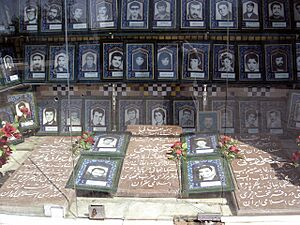
Today, Qazvin is a hub for the textile trade, including cotton, silk, and velvet. It's also known for leather products. The city is connected by railroad and highway to Tehran and Tabriz. Qazvin is home to the Shahid Raja'i power plant, which provides 7% of Iran's electricity!
Colleges and Universities
Qazvin has many places for higher education, including:
- Imam Khomeini International University
- Islamic Azad University of Qazvin
- Qazvin University of Medical Sciences
Modern Buildings and Shopping
Qazvin has several tall residential towers like Punak and Tejarat Tower, which has 28 floors. You can also find many shopping complexes, such as City Star and Ferdowsi.
Bridges and Hotels
The city has several bridges, including Naderi and Molasadra. If you're looking for a place to stay, Qazvin has many hotels, like the Alborz and Safir.
Parks for Fun and Relaxation
Qazvin offers many parks where you can relax and have fun. Some popular ones are Shohada Park, Mellat Park, and Fadak (Barajin) Park.
Getting Around Qazvin
Qazvin has different ways to get around:
- Qazvin railway station for train travel.
- Qazvin Airport for flights.
- Bus terminals for bus travel to other cities.
Sports in Qazvin
Qazvin is known for its talented athletes. The city has focused a lot on sports teams recently.
- Techmash is a basketball team that joined Iran's top league in 2013.
- Shams Azar is the local football (soccer) team, playing in the Persian Gulf Pro League.
The city also has several important sports complexes, including Sardare Azadegan Stadium and Shahid Rajai Stadium.
Famous People from Qazvin
Many notable people have come from Qazvin throughout history:
Historical Figures
- Ibn Majah: A famous scholar who wrote one of the most important collections of Hadith (sayings of Prophet Muhammad).
- Hamdollah Mostowfi: A great historian and writer from the 14th century.
- Zakariya Qazvini: A 13th-century writer and geographer.
- Ubayd Zakani: A famous poet from the 8th century known for his funny and sometimes rude verses.
- Mir Emad Hassani: A very famous calligrapher.
Modern Personalities
- Ali Akbar Dehkhoda: A well-known linguist who created Iran's first modern Persian dictionary.
- Shirin Neshat: A famous contemporary Iranian artist.
- Alireza Jahanbakhsh: A professional footballer who plays for Feyenoord and the Iranian national team.
Buried in Qazvin
Some important figures are buried in Qazvin:
- Uwais Qarni: An early Islamic figure.
- Ahmad Ghazali: A famous Iranian Sufi who died in 1126 CE.
- Shahzadeh Hossein: A Shiite saint.
- Abbas Babaei: A Brigadier General in the Iranian Air Force.
Sister Cities Around the World
Qazvin has "twin towns" or "sister cities" in other countries, which means they share cultural and economic ties:
 Évora, Portugal (since 2016)
Évora, Portugal (since 2016) Baalbek, Lebanon (since 2015)
Baalbek, Lebanon (since 2015) Bishkek, Kyrgyzstan (since 2011)
Bishkek, Kyrgyzstan (since 2011) Denizli, Turkey (since 2012)
Denizli, Turkey (since 2012) Shah Alam, Malaysia (since 2011)
Shah Alam, Malaysia (since 2011)
Images for kids
See also
- Caspians
- List of famous ab anbars of Qazvin (Ab anbars are traditional Iranian water reservoirs)
- Qazwini (disambiguation) (A name meaning "from Qazvin")



